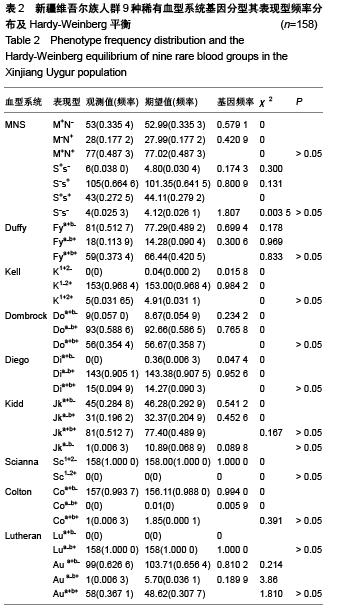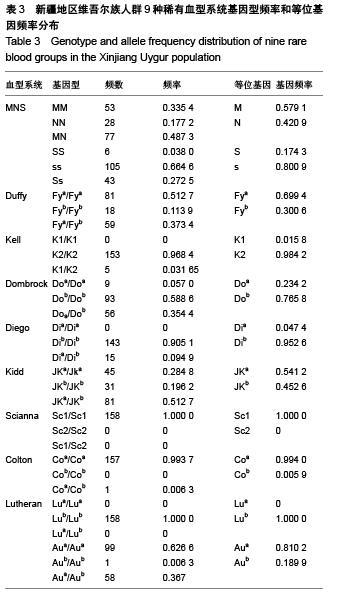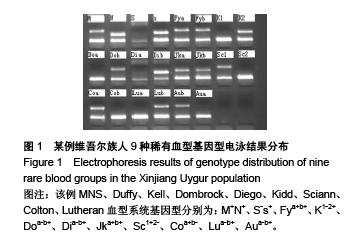中国组织工程研究 ›› 2016, Vol. 20 ›› Issue (1): 123-127.doi: 10.3969/j.issn.2095-4344.2016.01.022
• 干细胞临床实践 clinical practice of stem cells • 上一篇 下一篇
中国新疆维吾尔族人群MNS、Duffy和Kell等稀有血型的基因分子遗传分析
林国跃1,杜小璐1,单金晶1,张雅楠1,张玉强1,张元洲2
- 解放军第474医院,1输血科,2医务处,新疆维吾尔自治区乌鲁木齐市 830013
Molecular genetic analysis of genes from MNS, Duffy and Kell blood groups in the China Xinjiang Uygur population
Lin Guo-yue1, Du Xiao-lu1, Shan Jin-jing1, Zhang Ya-nan1, Zhang Yu-qiang1, Zhang Yuan-zhou2
- 1Department of Blood Transfusion, 2Department of Medical Service, the 474th Hospital of PLA, Urumqi 830013, Xinjiang Uygur Autonomous Region, China
摘要:
文章快速阅读:
.jpg)
文题释义:
稀有血型:当一个人的某种血型抗原在人群中出现的频率小于1‰时,称为稀有血型。随着血型血清学的深入研究,科学家们已将所发现的稀有血型,分别建立起稀有血型系统,如RH、MNS、KELL、KIDD、LUTHERAN、DIEGO、LEWIS、DUFFY以及其他一系列稀有血型系统。
基因频率:在一个种群基因库中,某个基因占全部等位基因数的比例。种群中某一基因位点上各种不同的基因频率之和以及各种基因型频率之和都等于1。对于一个种群来说,理想状态下种群基因频率在世代相传中保持稳定,然而在自然条件下却受基因突变、基因重组、自然选择、迁移和遗传漂变的影响,种群基因频率处于不断变化之中,使生物不断向前发展进化。因此,通过计算某种群的基因频率有利于理解该种群的进化情况。
背景:欧、美、日等都先后实施和完成了相关的稀有血型筛选项目,但国内还有较大差距,研究主要集中在南方地区汉族人群,对新疆地区维吾尔族人群稀有血型基因频率用PCR-SSP方法进行系统研究的报道较少。
目的:探讨新疆维吾尔族人群红细胞MNS、Duffy、Kell、Dombrock、Diego、Kidd、Scianna、Colton和Lutheran血型系统基因频率分布情况,为人类群体遗传学及临床科学调配合适血液提供战略支撑。
方法:采用PCR-SSP法对158名新疆维吾尔族人群9个稀有血型系统进行基因分型和统计学分析。
结果与结论:新疆维吾尔族人群9个稀有血型基因频率依次为M=0.579 1,N=0.420 9,S=0.174 3,s=0.800 9,Fya=0.699 4,Fyb=0.300 6,K1=0.015 8,K2=0.984 2,Doa=0.234 2,Dob=0.765 8,Dia=0.047 4,Dib= 0.952 6,JKa=0.541 2,JKb=0.452 6,Sc1=1.000,Sc2=0,Coa=0.994,Cob=0.005 9,Lua=0,Lub=1.000,Aua=0.810 2,Aub=0.189 9,用χ2检验比较基因型分布的观察值与期望值符合Hardy-Weinberg平衡法则(P > 0.05),且发现维族人群MNS血型系统基因表现型罕见存在S-s- 4例频率为0.025 3,Jka-b-1例频率为0.006 3。结果表明新疆维吾尔族人群MNS、Duffy、Dombrock和Diego 4种血型系统频率分布与其他种族明显不同,具有独特的自身分布频率特点;Kell、Kidd和Colton基因分布与报道的藏族、汉族其他人群分布相似又有差异;Scianna和Lutheran呈单态性分布,与藏族、汉族其他人群分布特点相同。该成果对探讨新疆维吾尔族人群起源进化、民族血液学研究以及稀有血型库的建设等方面提供了基本数据,具有重要意义。
ORCID: 0000-0001-9472-8833(林国跃)



.jpg) 根据基因在外显子或内含子不同的特异性碱基替换,设计该特异性碱基为正义链引物的3’末端,由于Taq酶缺乏3’-5’外切酶活性,与引物3’末端不相配的等位基因模板不能进行扩增,而与引物3’末端相配的等位基因顺利扩增。内参质控品为人类生长激素基因(HGH)的保守片段设计内参引物,存在于每个引物孔中,且在每次实验中运行。因其存在于所有人类的DNA样本中,该扩增产物可在所有有效实验中被电泳检出。①扩增步骤:首先提取样本DNA,最佳质量浓度50 mg/L。②反应条件:按要求设定PCR仪循环参数,96 ℃/2 min 1 cycle;96 ℃/20 s,68 ℃/60 s,5 cycles;96 ℃/20 s,65 ℃/45 s,72 ℃/30 s 10 cycles;96 ℃/20 s,62 ℃/45 s,72 ℃/30 s 15 cycles;72 ℃/3 min 1 cycle;
根据基因在外显子或内含子不同的特异性碱基替换,设计该特异性碱基为正义链引物的3’末端,由于Taq酶缺乏3’-5’外切酶活性,与引物3’末端不相配的等位基因模板不能进行扩增,而与引物3’末端相配的等位基因顺利扩增。内参质控品为人类生长激素基因(HGH)的保守片段设计内参引物,存在于每个引物孔中,且在每次实验中运行。因其存在于所有人类的DNA样本中,该扩增产物可在所有有效实验中被电泳检出。①扩增步骤:首先提取样本DNA,最佳质量浓度50 mg/L。②反应条件:按要求设定PCR仪循环参数,96 ℃/2 min 1 cycle;96 ℃/20 s,68 ℃/60 s,5 cycles;96 ℃/20 s,65 ℃/45 s,72 ℃/30 s 10 cycles;96 ℃/20 s,62 ℃/45 s,72 ℃/30 s 15 cycles;72 ℃/3 min 1 cycle;